Thyme is an herb that has a long and varied history. It’s been used for centuries in traditional medicine, cooking, and insect repellent. Thymol, one of its key active ingredients, has antiseptic and antimicrobial properties, which have earned it praise as a natural remedy for various ailments. The herb is native to the Mediterranean but can now be found in many parts of the world, including North America.
History of Thyme:
Thyme has been used since ancient times by cultures all over the globe for its medicinal qualities and culinary uses. In Ancient Egypt, it was believed to ward off evil spirits and cure diseases such as tuberculosis. Ancient Greeks used thyme in their cooking, fumigating, and the scent of their homes. During the Middle Ages, thyme was used in stews and soups to add flavor, increase nutrition, and burn in fires to ward off plague-carrying fleas.
Types of Thyme:
There are many varieties of thyme, each with its distinct flavor and aroma. Common varieties include:
- Lemon Thyme – This variety has a strong citrusy scent and taste. It pairs particularly well with fish, poultry, and vegetable dishes.
- Orange Thyme – As the name suggests, this type of thyme has an intense orange scent and flavor that is perfect for adding to desserts or cocktails.
- French Thyme – This type of thyme gives off a sweeter, milder aroma and flavor than other varieties. It’s often used in baking and making stews or soups.
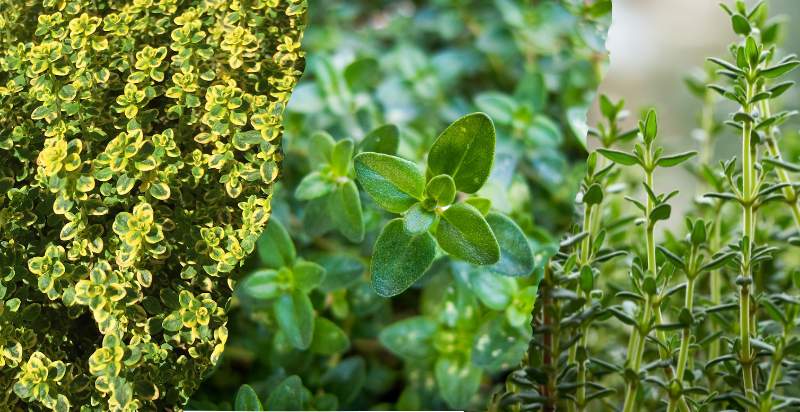
Nutritional Benefits of Thyme:
Thyme is a rich source of vitamins A, C, E, and K and minerals such as calcium, zinc, magnesium, potassium, and manganese. It also contains essential oils, including thymol which has powerful antiseptic properties. Thymol can be used topically for skin care or internally for respiratory problems like coughs and bronchitis.
Health Benefits of Thyme:
Thyme has been used in traditional medicine for centuries to treat various ailments. Some of these include:
- Coughs and colds – Thyme can be used to make an herbal tea that helps reduce coughing and relieve congestion associated with colds and flu.
- Asthma – Thyme’s anti-inflammatory properties may relieve asthmatic symptoms such as wheezing or difficulty breathing.
- Skincare – Due to its antiseptic and antimicrobial properties, thyme can be used to help treat acne, eczema, and other skin conditions.
Uses of Thyme:
Thyme is a versatile herb that can be used in many different ways. Some of the most popular uses include:
- Cooking – Thyme adds flavor to soups, stews, sauces, and other dishes. It pairs particularly well with pork, poultry, fish, and vegetables.
- Aromatherapy – The oil from thyme has a pleasant scent which can be used in aromatherapy to reduce stress and improve mood.
- Insect Repellent – Thyme is also said to be effective against certain types of pests such as fleas, ticks, and bed bugs.
Culinary Uses of Thyme:
Thyme’s distinctive flavor and aroma make it an ideal addition to various recipes. It’s commonly used in Mediterranean dishes like marinades, stews, and sauces. It also pairs well with poultry and fish dishes as a flavorful accent. In some areas, thyme is even added to desserts for an extra layer of sweetness.
Medicinal Benefits of Thyme:
In addition to its culinary uses, thyme has been found to provide numerous medicinal benefits. Research suggests that thymol, one of its active ingredients, may be effective at killing bacteria and fighting off infections. Thyme is also known for its antifungal properties, which can help treat skin conditions such as athlete’s foot or ringworm. It’s also an expectorant to calm coughing and can even reduce inflammation and boost the immune system.
Thyme is an incredibly versatile herb with various uses and health benefits. From adding flavor to cooking to providing relief from skin conditions and even repelling insects, it’s no wonder why thyme has been used for centuries! If you want to incorporate more herbs into your diet or health routine, consider adding a bit of thyme!
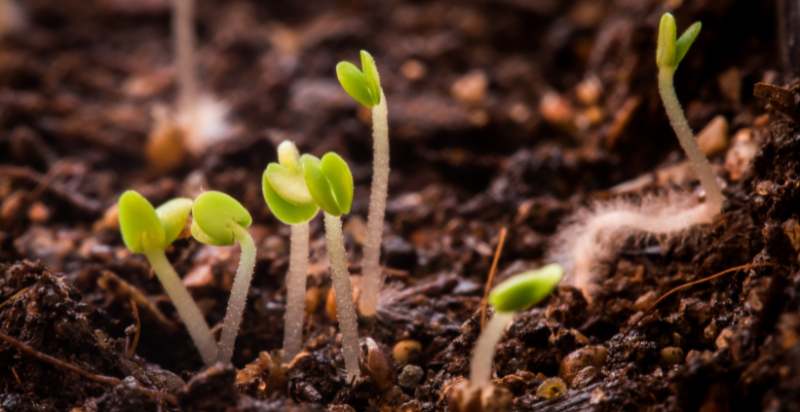
How to Plant Thyme?
Thyme is an herb commonly used in cooking and has numerous health benefits. It can be grown easily and with minimal effort, making it a great choice for beginner gardeners. This guide will cover the basics of planting thyme, including what soil to use, when to plant it, and how to care for your plants after they have sprouted.
What You Will Need
- Thyme seeds or seedlings
- A trowel or shovel
- Compost or potting soil
- Watering can
- Plant markers (optional)
Instructions:
- Choose a sunny location in your outdoor space that receives at least 6 hours of full sun daily. The soil should be well-drained and moist, as thyme prefers dry conditions.
- Dig a small hole in the ground slightly larger than your thyme plant’s root ball. When planting seeds, leave enough space between them for each plant to grow.
- Add some compost or potting soil to the bottom of the hole and mix it with the existing soil. This will help promote drainage and provide nutrients for your plants.
- Place your thyme seedling or seeds into the hole and cover it with more compost or potting soil, firmly pressing down, so it is secure.
- Water the area around your thyme plant and give it a good drink. During the summer months, you should water it twice a week; in the winter, once or twice a month is usually enough.
- Add some mulch around the base of your thyme plants to help retain moisture and prevent weed growth. If desired, you can also add some plant markers so that you know which plants are which in case they look similar as they grow.
- Once your thyme plants have grown a few inches tall, you can begin harvesting leaves to use in recipes or for medicinal purposes. Make sure to leave enough on each stem so the plant can continue growing and thriving!
Planting thyme is a great way to bring flavor and nutrition into your diet. You can easily grow thyme plant in your outdoor space or pots with just a few simple steps. Follow the instructions above for the best results, and enjoy harvesting fresh thyme all year!
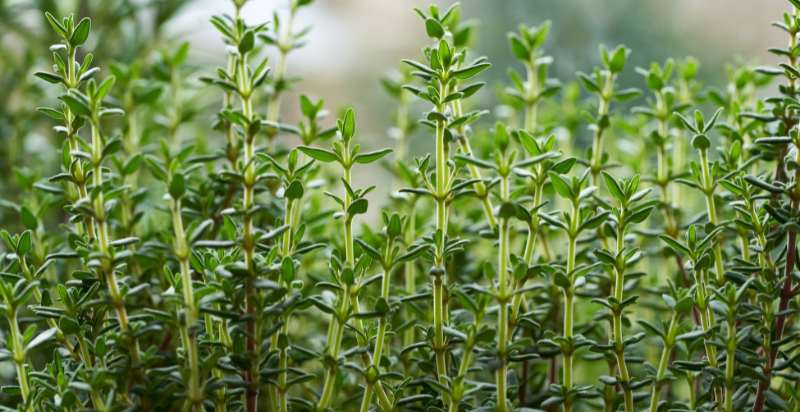
How to Care for Thyme Plant?
Caring for thyme plant is relatively easy once you understand its needs. Thyme requires plenty of sunlight and well-drained soil to thrive, so ensure the area you choose receives at least 6 hours of direct sunlight daily. Additionally, water your plants regularly – about twice a week during summer months and once or twice a month in winter – and add mulch around the base to help retain moisture.
You can fertilize your plants lightly every few weeks with an all-purpose fertilizer, but be careful not to overdo it, as too much fertilizer can damage your plants. Additionally, if you notice any signs of disease or pest infestation on your thyme plants, immediately remove affected leaves or stems and treat them with a fungicide or insecticide as necessary.
Finally, you can harvest your thyme plants at any time – make sure to leave enough on the stem so the plant can continue growing. Enjoy reaping the rewards of your homegrown thyme!
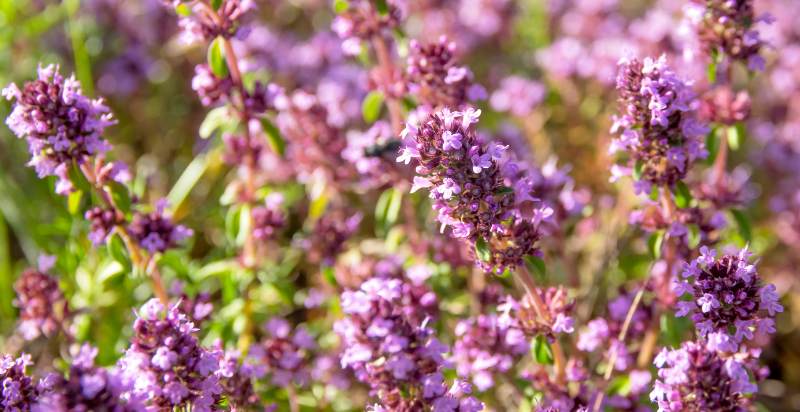
Preventions From Pests And Diseases:
To prevent your thyme plants from becoming infested with pests or diseases, you can do a few things. First, regularly remove weeds and debris around the garden to discourage insect breeding grounds. Additionally, use natural predators such as ladybugs and lacewings to keep pest populations in check.
You should also avoid over-watering your plants and ensure they have plenty of air circulation. If you notice any signs of disease or pest infestation on your thyme plants, such as wilting leaves or discolored spots, remove affected leaves or stems immediately and treat them with a fungicide or insecticide as necessary. These steps will help ensure that your thyme plants stay healthy and produce quality harvests all season long.
How to Harvest Thyme?
Harvesting thyme is a simple process that will reward you with flavorful leaves all season long. The best time to harvest is usually when the flowers are just starting to appear, as the leaves will be at their most flavorful. However, you can also harvest before and after this period – make sure to leave enough on the stem so the plant can continue growing.
Use your fingers or scissors to remove fresh leaves from the stems to harvest thyme. You can then store these in airtight containers in a refrigerator for up to a week or dry them using a dehydrator for longer storage. Enjoy reaping all the culinary and medicinal benefits of harvesting your thyme!
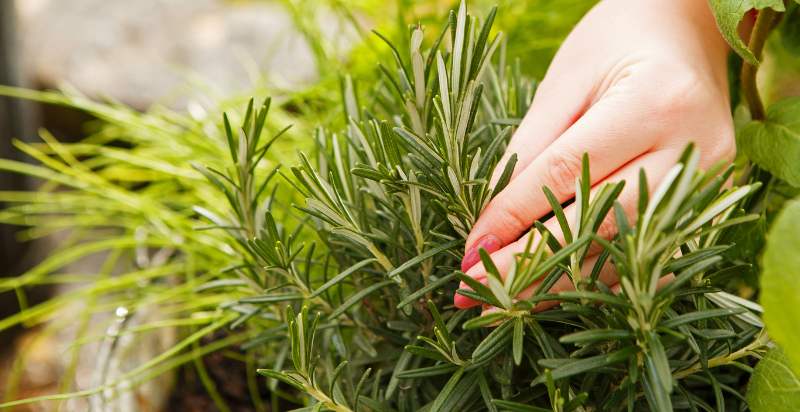
How to Store Homegrown Thyme?
Once you have harvested your thyme, you will want to store it properly to ensure it stays fresh. To do so, hang the sprigs upside down in a dry and cool area for several days until all the moisture dissipates. Then, use a food processor, mortar, and pestle to grind the leaves into a fine powder before transferring them into an airtight container.
You can also store whole thyme leaves by freezing them on a baking sheet. Once they are frozen solid, transfer them into freezer-safe containers or bags and freeze them for up to 6 months. By taking these steps, you can enjoy homegrown thyme all year round!
How to Use Thyme?
Thyme has a variety of uses, both culinary and medicinal. In cooking, thyme is commonly used in savory dishes such as soups, stews, or roasted vegetables. It can also be added to marinades for meats or sprinkled over salads for an aromatic and flavorful twist.
In addition to being used as an herb in cooking, thyme has many medicinal uses due to its antiseptic properties. An infusion made from the leaves can be used as a gargle to treat sore throat and laryngitis, while the essential oil is often used in aromatherapy treatments to relieve stress and improve sleep quality. Therefore, it’s no wonder why so many people use this versatile herb in their daily lives!

Potential Risks From Thyme:
Although thyme is generally safe to consume, it can cause some side effects if taken in large amounts or if you are allergic to it. Symptoms of an allergy may include itching, rash, shortness of breath, and swelling. Additionally, essential oil should not be ingested as it can be toxic in high doses. Furthermore, pregnant women should avoid using thyme as it can stimulate uterine contractions. Thus, it’s important to consult your doctor before consuming large amounts of this herb.
Conclusion:
Thyme is a versatile herb that can be used both in cooking and for medicinal purposes. By taking the necessary steps to prevent pests and diseases, harvesting thyme properly, and storing it correctly, you can enjoy homegrown thyme all season long. So, if you’re looking for an easy way to add flavor and health benefits to your meals, why not give growing thyme a try? You won’t regret it!
- Everything You Wanted to Know About Red Tamarillos - June 2, 2025
- A Guide to Tulips: Everything You Need to Know & More… - June 2, 2025
- Guanabana: Description, Flavor, Benefits, And Uses - May 27, 2025

20 thoughts on “What Is Thyme? Planting, Growing and Using the Thyme Herb”
Comments are closed.